7002ENG: Ratan Tata's Leadership, Communication & Achievements
VerifiedAdded on 2023/06/10
|11
|4365
|418
Report
AI Summary
This report provides an in-depth analysis of Ratan Tata's leadership and communication style, highlighting his impact on the Tata Group and the global business landscape. It explores his background, achievements, and leadership qualities, categorizing his approaches based on various leadership theories such as the Five-Factor Model, Behavior Theory, Max Weber's Leadership Model, and Bennis & Nanus Transformational Leadership. The report emphasizes Tata's focus on ethical leadership, employee empowerment, and social responsibility, illustrating how he transformed Tata Group from a domestic operation to a global powerhouse. It also discusses his strategic decisions, including the acquisition of Corus, and his commitment to improving the living standards of Indian citizens, showcasing his unique blend of business acumen and humanitarian values. The analysis draws on the Griffith University 7002ENG assignment criteria to assess the quality of the leadership analysis.
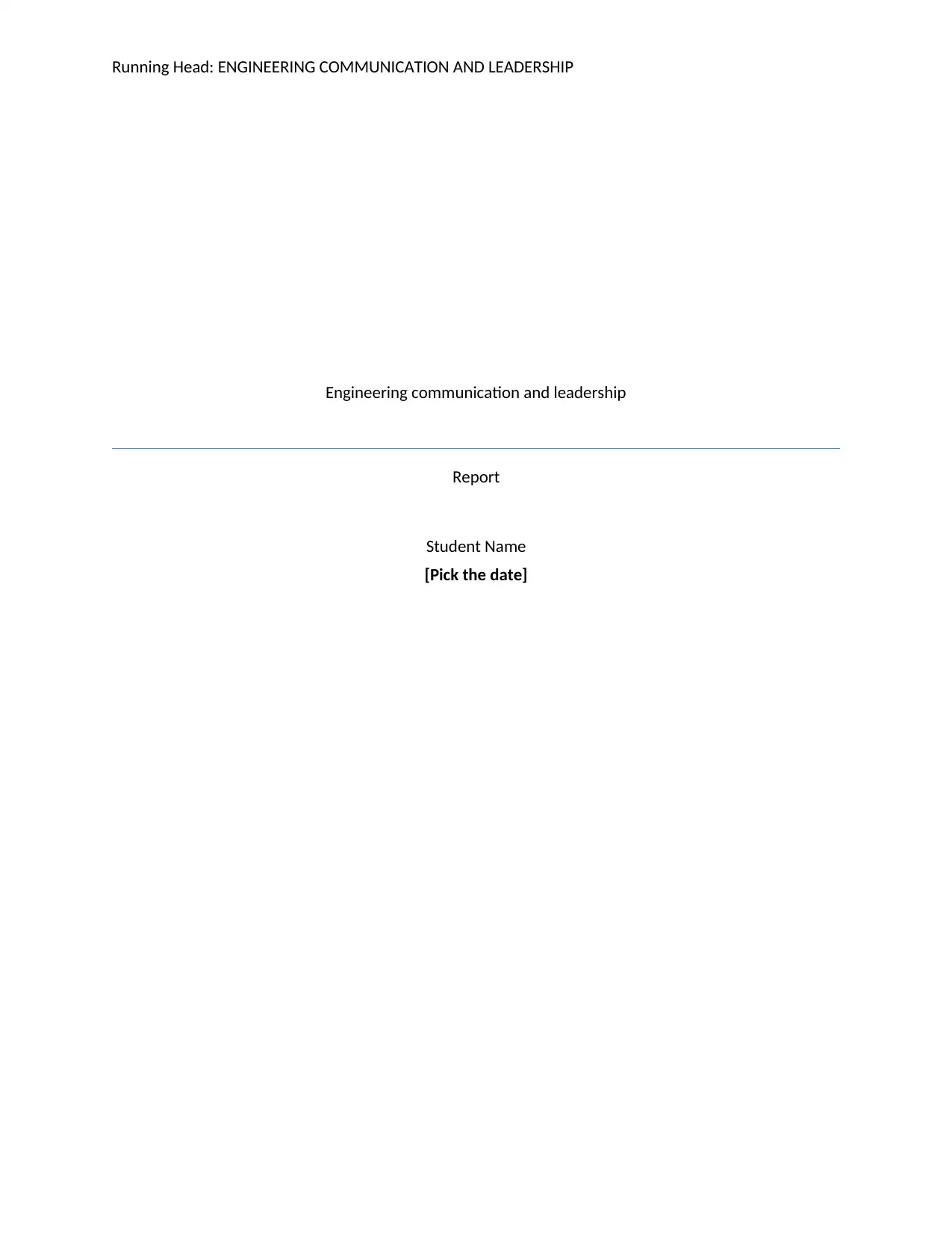
Running Head: ENGINEERING COMMUNICATION AND LEADERSHIP
Engineering communication and leadership
Report
Student Name
[Pick the date]
Engineering communication and leadership
Report
Student Name
[Pick the date]
Paraphrase This Document
Need a fresh take? Get an instant paraphrase of this document with our AI Paraphraser
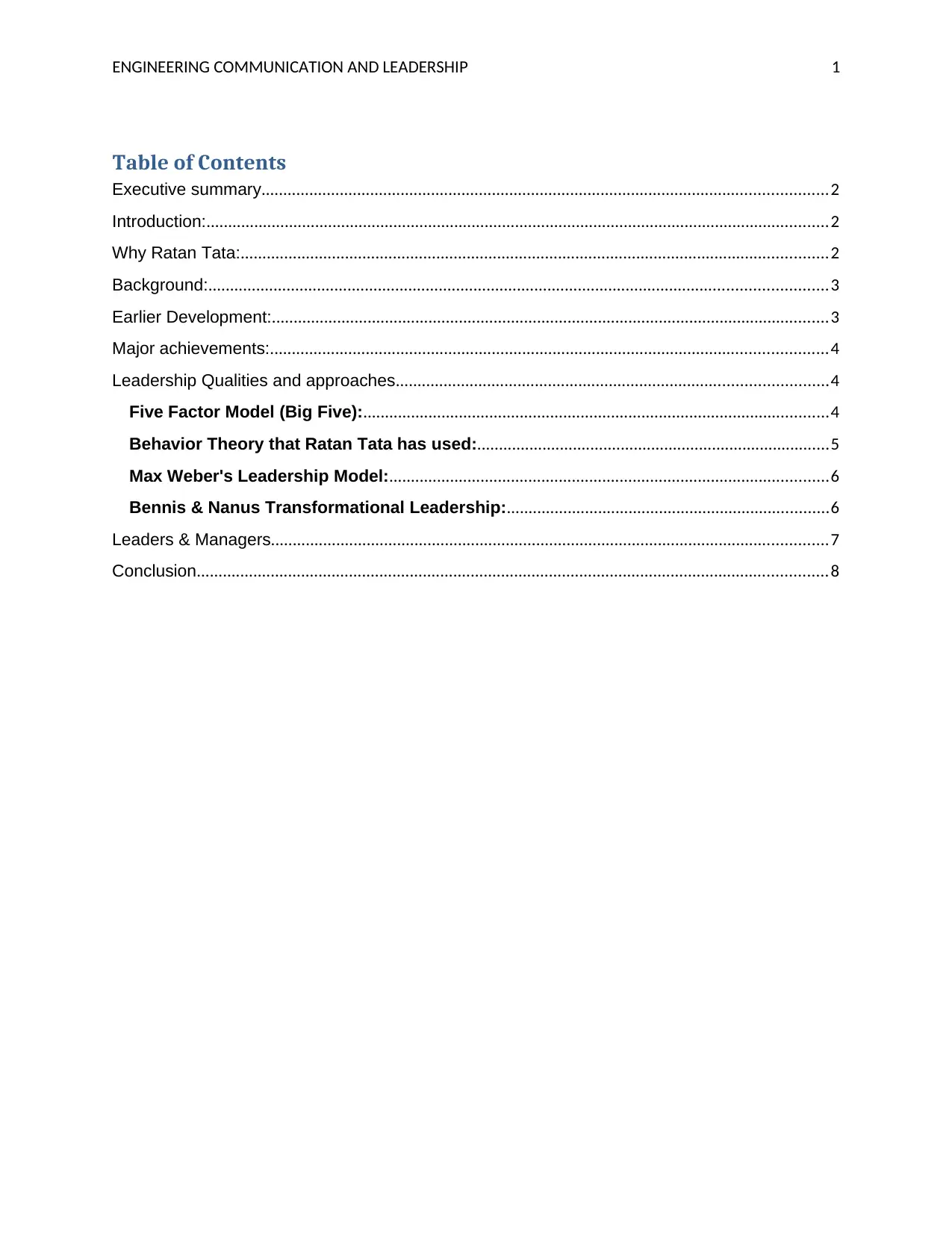
ENGINEERING COMMUNICATION AND LEADERSHIP 1
Table of Contents
Executive summary..................................................................................................................................2
Introduction:...............................................................................................................................................2
Why Ratan Tata:.......................................................................................................................................2
Background:..............................................................................................................................................3
Earlier Development:................................................................................................................................3
Major achievements:................................................................................................................................4
Leadership Qualities and approaches...................................................................................................4
Five Factor Model (Big Five):...........................................................................................................4
Behavior Theory that Ratan Tata has used:.................................................................................5
Max Weber's Leadership Model:.....................................................................................................6
Bennis & Nanus Transformational Leadership:..........................................................................6
Leaders & Managers................................................................................................................................7
Conclusion.................................................................................................................................................8
Table of Contents
Executive summary..................................................................................................................................2
Introduction:...............................................................................................................................................2
Why Ratan Tata:.......................................................................................................................................2
Background:..............................................................................................................................................3
Earlier Development:................................................................................................................................3
Major achievements:................................................................................................................................4
Leadership Qualities and approaches...................................................................................................4
Five Factor Model (Big Five):...........................................................................................................4
Behavior Theory that Ratan Tata has used:.................................................................................5
Max Weber's Leadership Model:.....................................................................................................6
Bennis & Nanus Transformational Leadership:..........................................................................6
Leaders & Managers................................................................................................................................7
Conclusion.................................................................................................................................................8
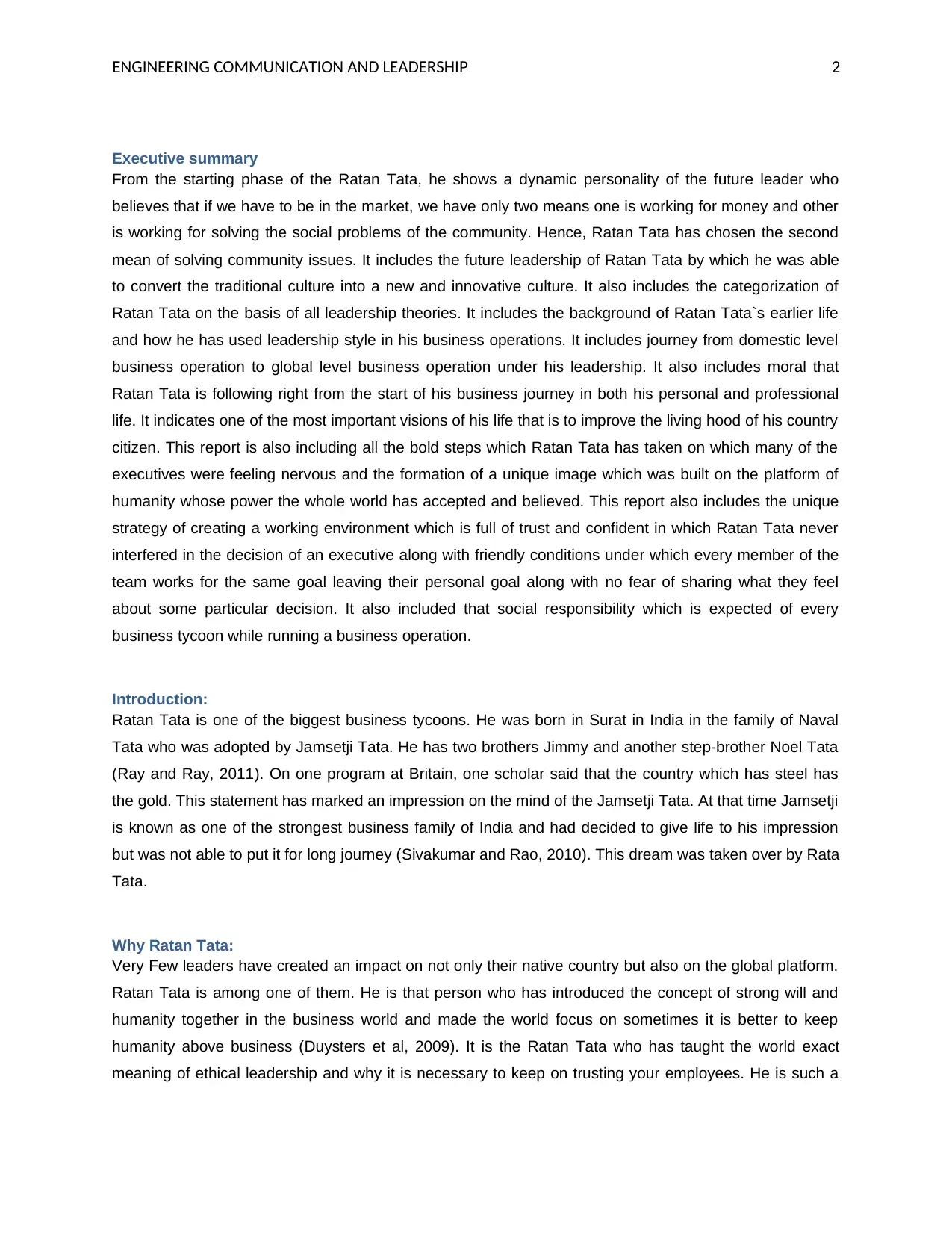
ENGINEERING COMMUNICATION AND LEADERSHIP 2
Executive summary
From the starting phase of the Ratan Tata, he shows a dynamic personality of the future leader who
believes that if we have to be in the market, we have only two means one is working for money and other
is working for solving the social problems of the community. Hence, Ratan Tata has chosen the second
mean of solving community issues. It includes the future leadership of Ratan Tata by which he was able
to convert the traditional culture into a new and innovative culture. It also includes the categorization of
Ratan Tata on the basis of all leadership theories. It includes the background of Ratan Tata`s earlier life
and how he has used leadership style in his business operations. It includes journey from domestic level
business operation to global level business operation under his leadership. It also includes moral that
Ratan Tata is following right from the start of his business journey in both his personal and professional
life. It indicates one of the most important visions of his life that is to improve the living hood of his country
citizen. This report is also including all the bold steps which Ratan Tata has taken on which many of the
executives were feeling nervous and the formation of a unique image which was built on the platform of
humanity whose power the whole world has accepted and believed. This report also includes the unique
strategy of creating a working environment which is full of trust and confident in which Ratan Tata never
interfered in the decision of an executive along with friendly conditions under which every member of the
team works for the same goal leaving their personal goal along with no fear of sharing what they feel
about some particular decision. It also included that social responsibility which is expected of every
business tycoon while running a business operation.
Introduction:
Ratan Tata is one of the biggest business tycoons. He was born in Surat in India in the family of Naval
Tata who was adopted by Jamsetji Tata. He has two brothers Jimmy and another step-brother Noel Tata
(Ray and Ray, 2011). On one program at Britain, one scholar said that the country which has steel has
the gold. This statement has marked an impression on the mind of the Jamsetji Tata. At that time Jamsetji
is known as one of the strongest business family of India and had decided to give life to his impression
but was not able to put it for long journey (Sivakumar and Rao, 2010). This dream was taken over by Rata
Tata.
Why Ratan Tata:
Very Few leaders have created an impact on not only their native country but also on the global platform.
Ratan Tata is among one of them. He is that person who has introduced the concept of strong will and
humanity together in the business world and made the world focus on sometimes it is better to keep
humanity above business (Duysters et al, 2009). It is the Ratan Tata who has taught the world exact
meaning of ethical leadership and why it is necessary to keep on trusting your employees. He is such a
Executive summary
From the starting phase of the Ratan Tata, he shows a dynamic personality of the future leader who
believes that if we have to be in the market, we have only two means one is working for money and other
is working for solving the social problems of the community. Hence, Ratan Tata has chosen the second
mean of solving community issues. It includes the future leadership of Ratan Tata by which he was able
to convert the traditional culture into a new and innovative culture. It also includes the categorization of
Ratan Tata on the basis of all leadership theories. It includes the background of Ratan Tata`s earlier life
and how he has used leadership style in his business operations. It includes journey from domestic level
business operation to global level business operation under his leadership. It also includes moral that
Ratan Tata is following right from the start of his business journey in both his personal and professional
life. It indicates one of the most important visions of his life that is to improve the living hood of his country
citizen. This report is also including all the bold steps which Ratan Tata has taken on which many of the
executives were feeling nervous and the formation of a unique image which was built on the platform of
humanity whose power the whole world has accepted and believed. This report also includes the unique
strategy of creating a working environment which is full of trust and confident in which Ratan Tata never
interfered in the decision of an executive along with friendly conditions under which every member of the
team works for the same goal leaving their personal goal along with no fear of sharing what they feel
about some particular decision. It also included that social responsibility which is expected of every
business tycoon while running a business operation.
Introduction:
Ratan Tata is one of the biggest business tycoons. He was born in Surat in India in the family of Naval
Tata who was adopted by Jamsetji Tata. He has two brothers Jimmy and another step-brother Noel Tata
(Ray and Ray, 2011). On one program at Britain, one scholar said that the country which has steel has
the gold. This statement has marked an impression on the mind of the Jamsetji Tata. At that time Jamsetji
is known as one of the strongest business family of India and had decided to give life to his impression
but was not able to put it for long journey (Sivakumar and Rao, 2010). This dream was taken over by Rata
Tata.
Why Ratan Tata:
Very Few leaders have created an impact on not only their native country but also on the global platform.
Ratan Tata is among one of them. He is that person who has introduced the concept of strong will and
humanity together in the business world and made the world focus on sometimes it is better to keep
humanity above business (Duysters et al, 2009). It is the Ratan Tata who has taught the world exact
meaning of ethical leadership and why it is necessary to keep on trusting your employees. He is such a
⊘ This is a preview!⊘
Do you want full access?
Subscribe today to unlock all pages.

Trusted by 1+ million students worldwide
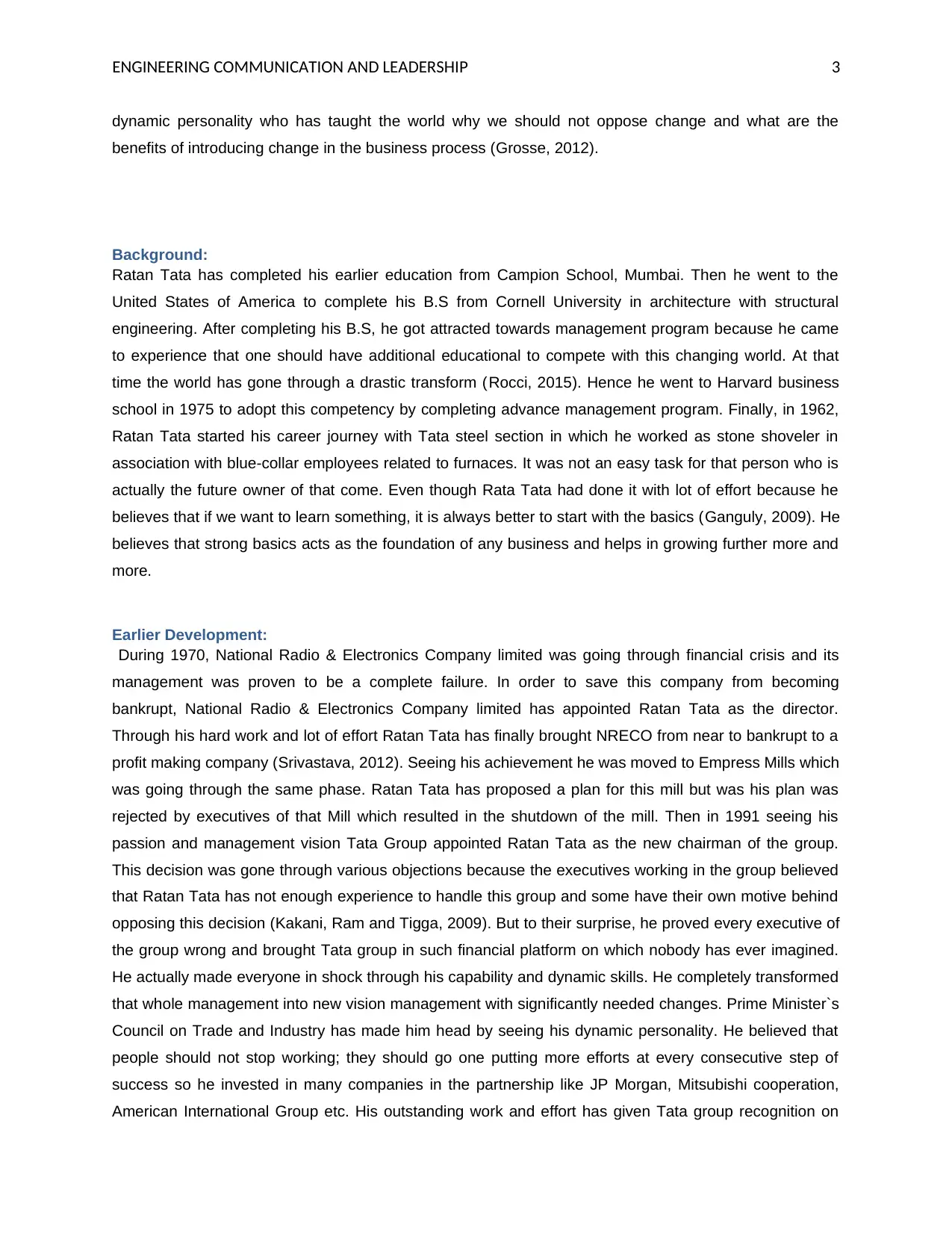
ENGINEERING COMMUNICATION AND LEADERSHIP 3
dynamic personality who has taught the world why we should not oppose change and what are the
benefits of introducing change in the business process (Grosse, 2012).
Background:
Ratan Tata has completed his earlier education from Campion School, Mumbai. Then he went to the
United States of America to complete his B.S from Cornell University in architecture with structural
engineering. After completing his B.S, he got attracted towards management program because he came
to experience that one should have additional educational to compete with this changing world. At that
time the world has gone through a drastic transform (Rocci, 2015). Hence he went to Harvard business
school in 1975 to adopt this competency by completing advance management program. Finally, in 1962,
Ratan Tata started his career journey with Tata steel section in which he worked as stone shoveler in
association with blue-collar employees related to furnaces. It was not an easy task for that person who is
actually the future owner of that come. Even though Rata Tata had done it with lot of effort because he
believes that if we want to learn something, it is always better to start with the basics (Ganguly, 2009). He
believes that strong basics acts as the foundation of any business and helps in growing further more and
more.
Earlier Development:
During 1970, National Radio & Electronics Company limited was going through financial crisis and its
management was proven to be a complete failure. In order to save this company from becoming
bankrupt, National Radio & Electronics Company limited has appointed Ratan Tata as the director.
Through his hard work and lot of effort Ratan Tata has finally brought NRECO from near to bankrupt to a
profit making company (Srivastava, 2012). Seeing his achievement he was moved to Empress Mills which
was going through the same phase. Ratan Tata has proposed a plan for this mill but was his plan was
rejected by executives of that Mill which resulted in the shutdown of the mill. Then in 1991 seeing his
passion and management vision Tata Group appointed Ratan Tata as the new chairman of the group.
This decision was gone through various objections because the executives working in the group believed
that Ratan Tata has not enough experience to handle this group and some have their own motive behind
opposing this decision (Kakani, Ram and Tigga, 2009). But to their surprise, he proved every executive of
the group wrong and brought Tata group in such financial platform on which nobody has ever imagined.
He actually made everyone in shock through his capability and dynamic skills. He completely transformed
that whole management into new vision management with significantly needed changes. Prime Minister`s
Council on Trade and Industry has made him head by seeing his dynamic personality. He believed that
people should not stop working; they should go one putting more efforts at every consecutive step of
success so he invested in many companies in the partnership like JP Morgan, Mitsubishi cooperation,
American International Group etc. His outstanding work and effort has given Tata group recognition on
dynamic personality who has taught the world why we should not oppose change and what are the
benefits of introducing change in the business process (Grosse, 2012).
Background:
Ratan Tata has completed his earlier education from Campion School, Mumbai. Then he went to the
United States of America to complete his B.S from Cornell University in architecture with structural
engineering. After completing his B.S, he got attracted towards management program because he came
to experience that one should have additional educational to compete with this changing world. At that
time the world has gone through a drastic transform (Rocci, 2015). Hence he went to Harvard business
school in 1975 to adopt this competency by completing advance management program. Finally, in 1962,
Ratan Tata started his career journey with Tata steel section in which he worked as stone shoveler in
association with blue-collar employees related to furnaces. It was not an easy task for that person who is
actually the future owner of that come. Even though Rata Tata had done it with lot of effort because he
believes that if we want to learn something, it is always better to start with the basics (Ganguly, 2009). He
believes that strong basics acts as the foundation of any business and helps in growing further more and
more.
Earlier Development:
During 1970, National Radio & Electronics Company limited was going through financial crisis and its
management was proven to be a complete failure. In order to save this company from becoming
bankrupt, National Radio & Electronics Company limited has appointed Ratan Tata as the director.
Through his hard work and lot of effort Ratan Tata has finally brought NRECO from near to bankrupt to a
profit making company (Srivastava, 2012). Seeing his achievement he was moved to Empress Mills which
was going through the same phase. Ratan Tata has proposed a plan for this mill but was his plan was
rejected by executives of that Mill which resulted in the shutdown of the mill. Then in 1991 seeing his
passion and management vision Tata Group appointed Ratan Tata as the new chairman of the group.
This decision was gone through various objections because the executives working in the group believed
that Ratan Tata has not enough experience to handle this group and some have their own motive behind
opposing this decision (Kakani, Ram and Tigga, 2009). But to their surprise, he proved every executive of
the group wrong and brought Tata group in such financial platform on which nobody has ever imagined.
He actually made everyone in shock through his capability and dynamic skills. He completely transformed
that whole management into new vision management with significantly needed changes. Prime Minister`s
Council on Trade and Industry has made him head by seeing his dynamic personality. He believed that
people should not stop working; they should go one putting more efforts at every consecutive step of
success so he invested in many companies in the partnership like JP Morgan, Mitsubishi cooperation,
American International Group etc. His outstanding work and effort has given Tata group recognition on
Paraphrase This Document
Need a fresh take? Get an instant paraphrase of this document with our AI Paraphraser
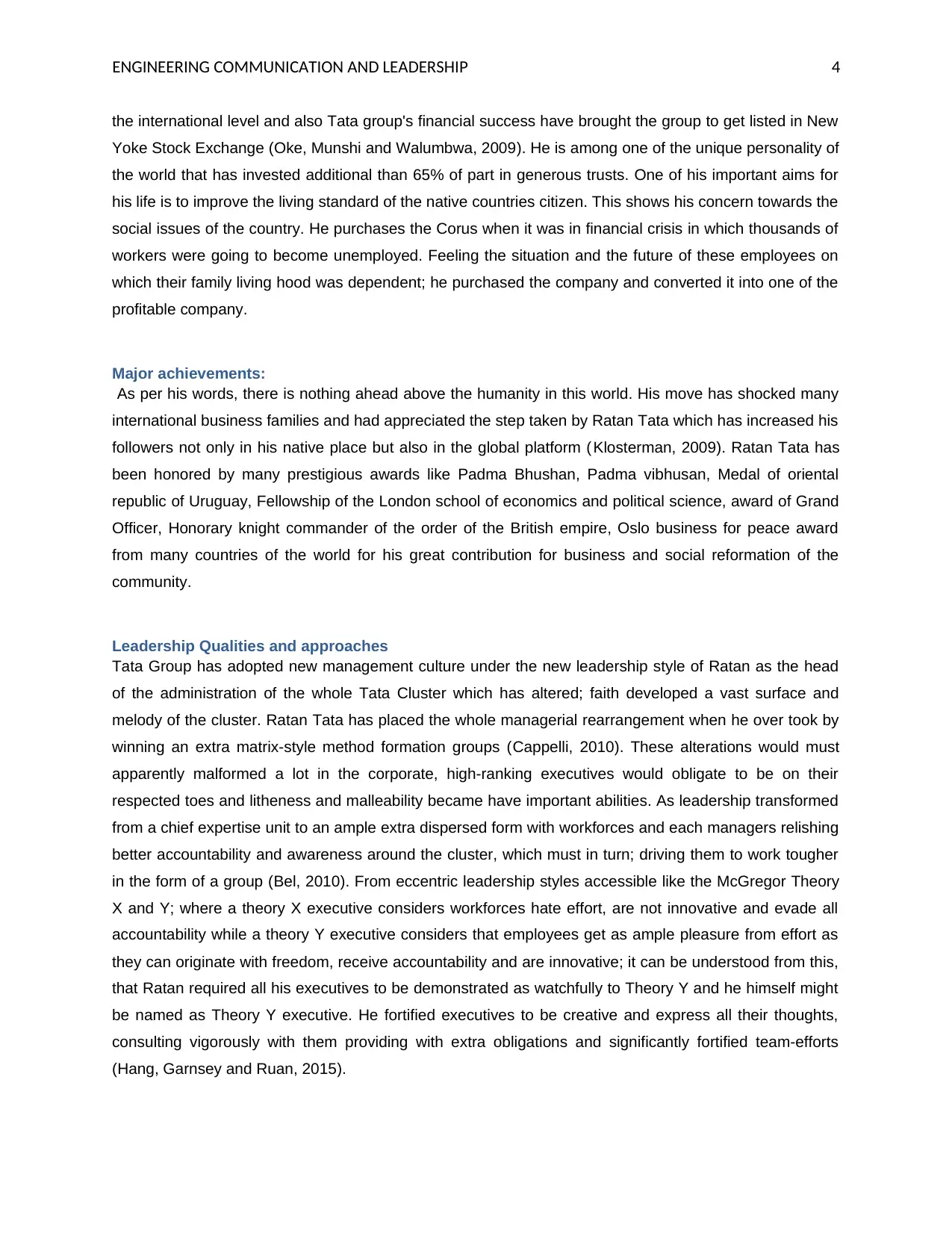
ENGINEERING COMMUNICATION AND LEADERSHIP 4
the international level and also Tata group's financial success have brought the group to get listed in New
Yoke Stock Exchange (Oke, Munshi and Walumbwa, 2009). He is among one of the unique personality of
the world that has invested additional than 65% of part in generous trusts. One of his important aims for
his life is to improve the living standard of the native countries citizen. This shows his concern towards the
social issues of the country. He purchases the Corus when it was in financial crisis in which thousands of
workers were going to become unemployed. Feeling the situation and the future of these employees on
which their family living hood was dependent; he purchased the company and converted it into one of the
profitable company.
Major achievements:
As per his words, there is nothing ahead above the humanity in this world. His move has shocked many
international business families and had appreciated the step taken by Ratan Tata which has increased his
followers not only in his native place but also in the global platform ( Klosterman, 2009). Ratan Tata has
been honored by many prestigious awards like Padma Bhushan, Padma vibhusan, Medal of oriental
republic of Uruguay, Fellowship of the London school of economics and political science, award of Grand
Officer, Honorary knight commander of the order of the British empire, Oslo business for peace award
from many countries of the world for his great contribution for business and social reformation of the
community.
Leadership Qualities and approaches
Tata Group has adopted new management culture under the new leadership style of Ratan as the head
of the administration of the whole Tata Cluster which has altered; faith developed a vast surface and
melody of the cluster. Ratan Tata has placed the whole managerial rearrangement when he over took by
winning an extra matrix-style method formation groups (Cappelli, 2010). These alterations would must
apparently malformed a lot in the corporate, high-ranking executives would obligate to be on their
respected toes and litheness and malleability became have important abilities. As leadership transformed
from a chief expertise unit to an ample extra dispersed form with workforces and each managers relishing
better accountability and awareness around the cluster, which must in turn; driving them to work tougher
in the form of a group (Bel, 2010). From eccentric leadership styles accessible like the McGregor Theory
X and Y; where a theory X executive considers workforces hate effort, are not innovative and evade all
accountability while a theory Y executive considers that employees get as ample pleasure from effort as
they can originate with freedom, receive accountability and are innovative; it can be understood from this,
that Ratan required all his executives to be demonstrated as watchfully to Theory Y and he himself might
be named as Theory Y executive. He fortified executives to be creative and express all their thoughts,
consulting vigorously with them providing with extra obligations and significantly fortified team-efforts
(Hang, Garnsey and Ruan, 2015).
the international level and also Tata group's financial success have brought the group to get listed in New
Yoke Stock Exchange (Oke, Munshi and Walumbwa, 2009). He is among one of the unique personality of
the world that has invested additional than 65% of part in generous trusts. One of his important aims for
his life is to improve the living standard of the native countries citizen. This shows his concern towards the
social issues of the country. He purchases the Corus when it was in financial crisis in which thousands of
workers were going to become unemployed. Feeling the situation and the future of these employees on
which their family living hood was dependent; he purchased the company and converted it into one of the
profitable company.
Major achievements:
As per his words, there is nothing ahead above the humanity in this world. His move has shocked many
international business families and had appreciated the step taken by Ratan Tata which has increased his
followers not only in his native place but also in the global platform ( Klosterman, 2009). Ratan Tata has
been honored by many prestigious awards like Padma Bhushan, Padma vibhusan, Medal of oriental
republic of Uruguay, Fellowship of the London school of economics and political science, award of Grand
Officer, Honorary knight commander of the order of the British empire, Oslo business for peace award
from many countries of the world for his great contribution for business and social reformation of the
community.
Leadership Qualities and approaches
Tata Group has adopted new management culture under the new leadership style of Ratan as the head
of the administration of the whole Tata Cluster which has altered; faith developed a vast surface and
melody of the cluster. Ratan Tata has placed the whole managerial rearrangement when he over took by
winning an extra matrix-style method formation groups (Cappelli, 2010). These alterations would must
apparently malformed a lot in the corporate, high-ranking executives would obligate to be on their
respected toes and litheness and malleability became have important abilities. As leadership transformed
from a chief expertise unit to an ample extra dispersed form with workforces and each managers relishing
better accountability and awareness around the cluster, which must in turn; driving them to work tougher
in the form of a group (Bel, 2010). From eccentric leadership styles accessible like the McGregor Theory
X and Y; where a theory X executive considers workforces hate effort, are not innovative and evade all
accountability while a theory Y executive considers that employees get as ample pleasure from effort as
they can originate with freedom, receive accountability and are innovative; it can be understood from this,
that Ratan required all his executives to be demonstrated as watchfully to Theory Y and he himself might
be named as Theory Y executive. He fortified executives to be creative and express all their thoughts,
consulting vigorously with them providing with extra obligations and significantly fortified team-efforts
(Hang, Garnsey and Ruan, 2015).
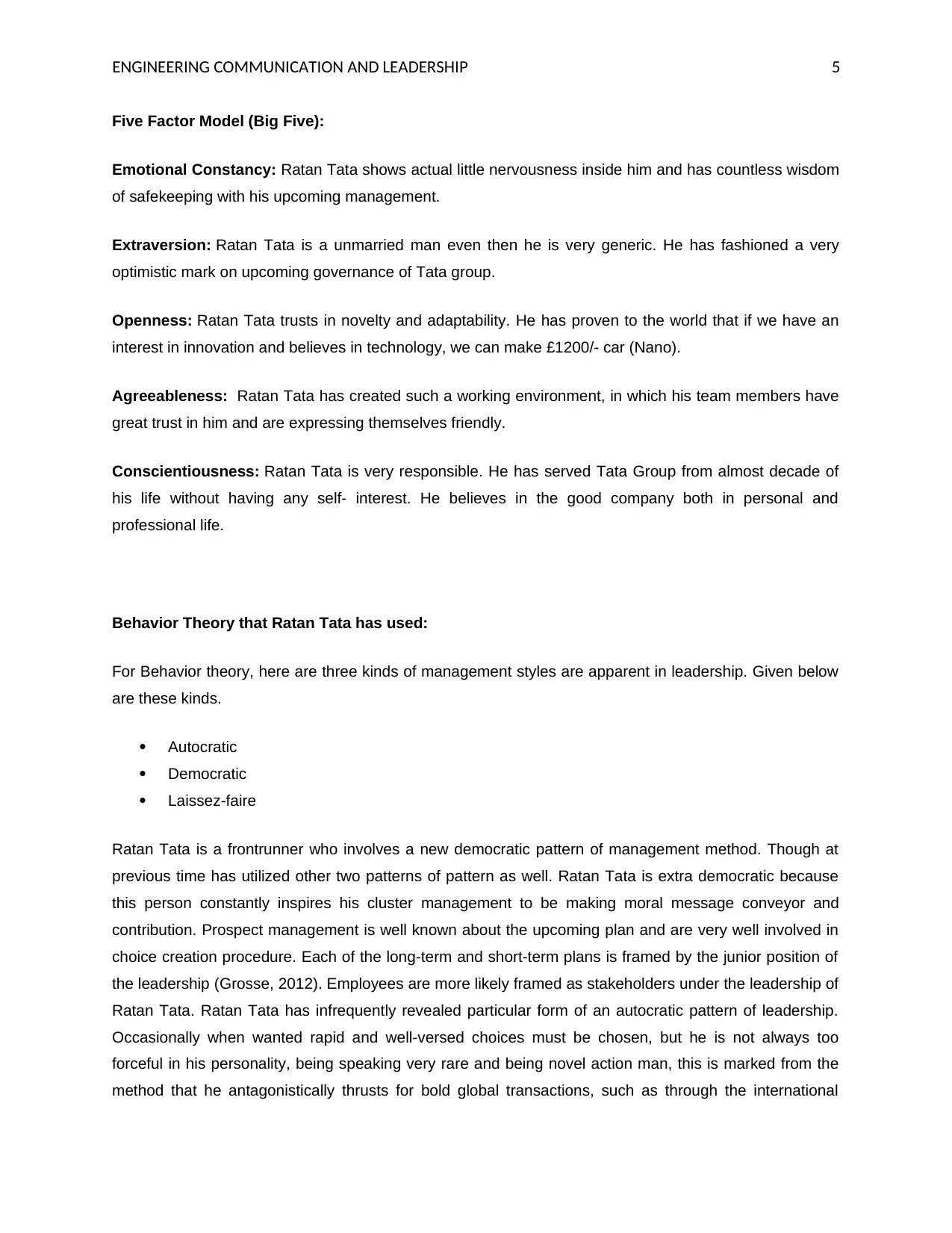
ENGINEERING COMMUNICATION AND LEADERSHIP 5
Five Factor Model (Big Five):
Emotional Constancy: Ratan Tata shows actual little nervousness inside him and has countless wisdom
of safekeeping with his upcoming management.
Extraversion: Ratan Tata is a unmarried man even then he is very generic. He has fashioned a very
optimistic mark on upcoming governance of Tata group.
Openness: Ratan Tata trusts in novelty and adaptability. He has proven to the world that if we have an
interest in innovation and believes in technology, we can make £1200/- car (Nano).
Agreeableness: Ratan Tata has created such a working environment, in which his team members have
great trust in him and are expressing themselves friendly.
Conscientiousness: Ratan Tata is very responsible. He has served Tata Group from almost decade of
his life without having any self- interest. He believes in the good company both in personal and
professional life.
Behavior Theory that Ratan Tata has used:
For Behavior theory, here are three kinds of management styles are apparent in leadership. Given below
are these kinds.
Autocratic
Democratic
Laissez-faire
Ratan Tata is a frontrunner who involves a new democratic pattern of management method. Though at
previous time has utilized other two patterns of pattern as well. Ratan Tata is extra democratic because
this person constantly inspires his cluster management to be making moral message conveyor and
contribution. Prospect management is well known about the upcoming plan and are very well involved in
choice creation procedure. Each of the long-term and short-term plans is framed by the junior position of
the leadership (Grosse, 2012). Employees are more likely framed as stakeholders under the leadership of
Ratan Tata. Ratan Tata has infrequently revealed particular form of an autocratic pattern of leadership.
Occasionally when wanted rapid and well-versed choices must be chosen, but he is not always too
forceful in his personality, being speaking very rare and being novel action man, this is marked from the
method that he antagonistically thrusts for bold global transactions, such as through the international
Five Factor Model (Big Five):
Emotional Constancy: Ratan Tata shows actual little nervousness inside him and has countless wisdom
of safekeeping with his upcoming management.
Extraversion: Ratan Tata is a unmarried man even then he is very generic. He has fashioned a very
optimistic mark on upcoming governance of Tata group.
Openness: Ratan Tata trusts in novelty and adaptability. He has proven to the world that if we have an
interest in innovation and believes in technology, we can make £1200/- car (Nano).
Agreeableness: Ratan Tata has created such a working environment, in which his team members have
great trust in him and are expressing themselves friendly.
Conscientiousness: Ratan Tata is very responsible. He has served Tata Group from almost decade of
his life without having any self- interest. He believes in the good company both in personal and
professional life.
Behavior Theory that Ratan Tata has used:
For Behavior theory, here are three kinds of management styles are apparent in leadership. Given below
are these kinds.
Autocratic
Democratic
Laissez-faire
Ratan Tata is a frontrunner who involves a new democratic pattern of management method. Though at
previous time has utilized other two patterns of pattern as well. Ratan Tata is extra democratic because
this person constantly inspires his cluster management to be making moral message conveyor and
contribution. Prospect management is well known about the upcoming plan and are very well involved in
choice creation procedure. Each of the long-term and short-term plans is framed by the junior position of
the leadership (Grosse, 2012). Employees are more likely framed as stakeholders under the leadership of
Ratan Tata. Ratan Tata has infrequently revealed particular form of an autocratic pattern of leadership.
Occasionally when wanted rapid and well-versed choices must be chosen, but he is not always too
forceful in his personality, being speaking very rare and being novel action man, this is marked from the
method that he antagonistically thrusts for bold global transactions, such as through the international
⊘ This is a preview!⊘
Do you want full access?
Subscribe today to unlock all pages.

Trusted by 1+ million students worldwide
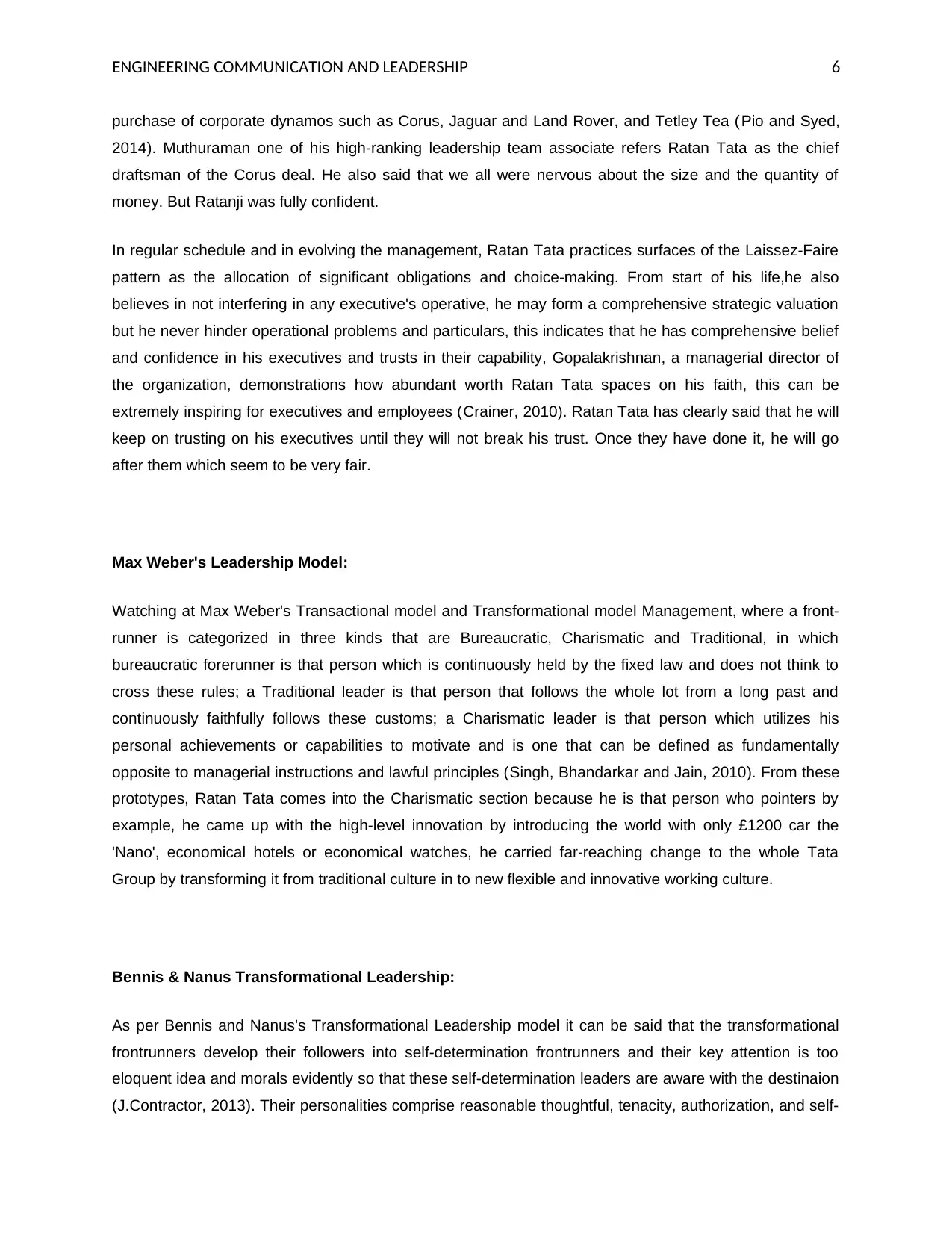
ENGINEERING COMMUNICATION AND LEADERSHIP 6
purchase of corporate dynamos such as Corus, Jaguar and Land Rover, and Tetley Tea (Pio and Syed,
2014). Muthuraman one of his high-ranking leadership team associate refers Ratan Tata as the chief
draftsman of the Corus deal. He also said that we all were nervous about the size and the quantity of
money. But Ratanji was fully confident.
In regular schedule and in evolving the management, Ratan Tata practices surfaces of the Laissez-Faire
pattern as the allocation of significant obligations and choice-making. From start of his life,he also
believes in not interfering in any executive's operative, he may form a comprehensive strategic valuation
but he never hinder operational problems and particulars, this indicates that he has comprehensive belief
and confidence in his executives and trusts in their capability, Gopalakrishnan, a managerial director of
the organization, demonstrations how abundant worth Ratan Tata spaces on his faith, this can be
extremely inspiring for executives and employees (Crainer, 2010). Ratan Tata has clearly said that he will
keep on trusting on his executives until they will not break his trust. Once they have done it, he will go
after them which seem to be very fair.
Max Weber's Leadership Model:
Watching at Max Weber's Transactional model and Transformational model Management, where a front-
runner is categorized in three kinds that are Bureaucratic, Charismatic and Traditional, in which
bureaucratic forerunner is that person which is continuously held by the fixed law and does not think to
cross these rules; a Traditional leader is that person that follows the whole lot from a long past and
continuously faithfully follows these customs; a Charismatic leader is that person which utilizes his
personal achievements or capabilities to motivate and is one that can be defined as fundamentally
opposite to managerial instructions and lawful principles (Singh, Bhandarkar and Jain, 2010). From these
prototypes, Ratan Tata comes into the Charismatic section because he is that person who pointers by
example, he came up with the high-level innovation by introducing the world with only £1200 car the
'Nano', economical hotels or economical watches, he carried far-reaching change to the whole Tata
Group by transforming it from traditional culture in to new flexible and innovative working culture.
Bennis & Nanus Transformational Leadership:
As per Bennis and Nanus's Transformational Leadership model it can be said that the transformational
frontrunners develop their followers into self-determination frontrunners and their key attention is too
eloquent idea and morals evidently so that these self-determination leaders are aware with the destinaion
(J.Contractor, 2013). Their personalities comprise reasonable thoughtful, tenacity, authorization, and self-
purchase of corporate dynamos such as Corus, Jaguar and Land Rover, and Tetley Tea (Pio and Syed,
2014). Muthuraman one of his high-ranking leadership team associate refers Ratan Tata as the chief
draftsman of the Corus deal. He also said that we all were nervous about the size and the quantity of
money. But Ratanji was fully confident.
In regular schedule and in evolving the management, Ratan Tata practices surfaces of the Laissez-Faire
pattern as the allocation of significant obligations and choice-making. From start of his life,he also
believes in not interfering in any executive's operative, he may form a comprehensive strategic valuation
but he never hinder operational problems and particulars, this indicates that he has comprehensive belief
and confidence in his executives and trusts in their capability, Gopalakrishnan, a managerial director of
the organization, demonstrations how abundant worth Ratan Tata spaces on his faith, this can be
extremely inspiring for executives and employees (Crainer, 2010). Ratan Tata has clearly said that he will
keep on trusting on his executives until they will not break his trust. Once they have done it, he will go
after them which seem to be very fair.
Max Weber's Leadership Model:
Watching at Max Weber's Transactional model and Transformational model Management, where a front-
runner is categorized in three kinds that are Bureaucratic, Charismatic and Traditional, in which
bureaucratic forerunner is that person which is continuously held by the fixed law and does not think to
cross these rules; a Traditional leader is that person that follows the whole lot from a long past and
continuously faithfully follows these customs; a Charismatic leader is that person which utilizes his
personal achievements or capabilities to motivate and is one that can be defined as fundamentally
opposite to managerial instructions and lawful principles (Singh, Bhandarkar and Jain, 2010). From these
prototypes, Ratan Tata comes into the Charismatic section because he is that person who pointers by
example, he came up with the high-level innovation by introducing the world with only £1200 car the
'Nano', economical hotels or economical watches, he carried far-reaching change to the whole Tata
Group by transforming it from traditional culture in to new flexible and innovative working culture.
Bennis & Nanus Transformational Leadership:
As per Bennis and Nanus's Transformational Leadership model it can be said that the transformational
frontrunners develop their followers into self-determination frontrunners and their key attention is too
eloquent idea and morals evidently so that these self-determination leaders are aware with the destinaion
(J.Contractor, 2013). Their personalities comprise reasonable thoughtful, tenacity, authorization, and self-
Paraphrase This Document
Need a fresh take? Get an instant paraphrase of this document with our AI Paraphraser
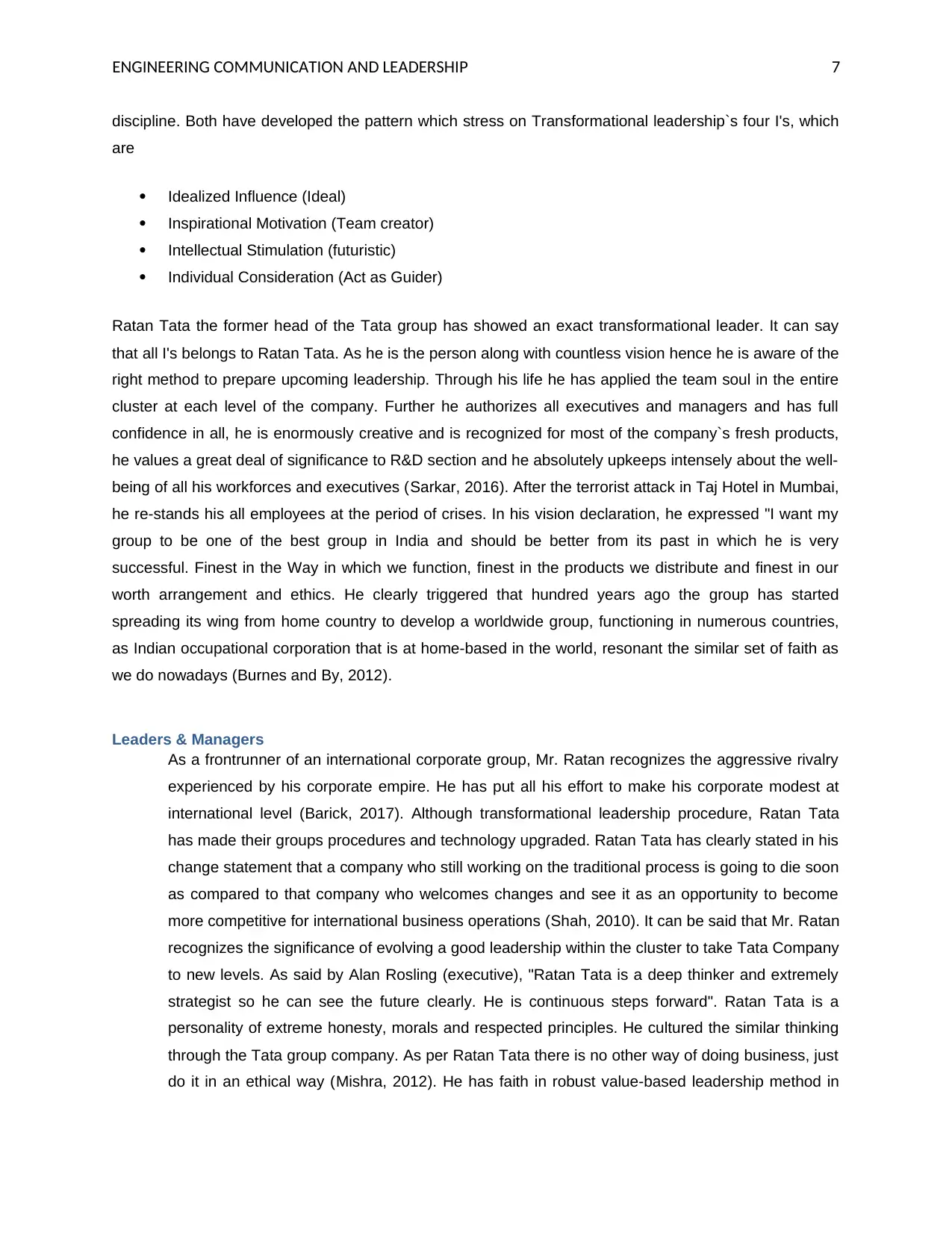
ENGINEERING COMMUNICATION AND LEADERSHIP 7
discipline. Both have developed the pattern which stress on Transformational leadership`s four I's, which
are
Idealized Influence (Ideal)
Inspirational Motivation (Team creator)
Intellectual Stimulation (futuristic)
Individual Consideration (Act as Guider)
Ratan Tata the former head of the Tata group has showed an exact transformational leader. It can say
that all I's belongs to Ratan Tata. As he is the person along with countless vision hence he is aware of the
right method to prepare upcoming leadership. Through his life he has applied the team soul in the entire
cluster at each level of the company. Further he authorizes all executives and managers and has full
confidence in all, he is enormously creative and is recognized for most of the company`s fresh products,
he values a great deal of significance to R&D section and he absolutely upkeeps intensely about the well-
being of all his workforces and executives (Sarkar, 2016). After the terrorist attack in Taj Hotel in Mumbai,
he re-stands his all employees at the period of crises. In his vision declaration, he expressed "I want my
group to be one of the best group in India and should be better from its past in which he is very
successful. Finest in the Way in which we function, finest in the products we distribute and finest in our
worth arrangement and ethics. He clearly triggered that hundred years ago the group has started
spreading its wing from home country to develop a worldwide group, functioning in numerous countries,
as Indian occupational corporation that is at home-based in the world, resonant the similar set of faith as
we do nowadays (Burnes and By, 2012).
Leaders & Managers
As a frontrunner of an international corporate group, Mr. Ratan recognizes the aggressive rivalry
experienced by his corporate empire. He has put all his effort to make his corporate modest at
international level (Barick, 2017). Although transformational leadership procedure, Ratan Tata
has made their groups procedures and technology upgraded. Ratan Tata has clearly stated in his
change statement that a company who still working on the traditional process is going to die soon
as compared to that company who welcomes changes and see it as an opportunity to become
more competitive for international business operations (Shah, 2010). It can be said that Mr. Ratan
recognizes the significance of evolving a good leadership within the cluster to take Tata Company
to new levels. As said by Alan Rosling (executive), "Ratan Tata is a deep thinker and extremely
strategist so he can see the future clearly. He is continuous steps forward". Ratan Tata is a
personality of extreme honesty, morals and respected principles. He cultured the similar thinking
through the Tata group company. As per Ratan Tata there is no other way of doing business, just
do it in an ethical way (Mishra, 2012). He has faith in robust value-based leadership method in
discipline. Both have developed the pattern which stress on Transformational leadership`s four I's, which
are
Idealized Influence (Ideal)
Inspirational Motivation (Team creator)
Intellectual Stimulation (futuristic)
Individual Consideration (Act as Guider)
Ratan Tata the former head of the Tata group has showed an exact transformational leader. It can say
that all I's belongs to Ratan Tata. As he is the person along with countless vision hence he is aware of the
right method to prepare upcoming leadership. Through his life he has applied the team soul in the entire
cluster at each level of the company. Further he authorizes all executives and managers and has full
confidence in all, he is enormously creative and is recognized for most of the company`s fresh products,
he values a great deal of significance to R&D section and he absolutely upkeeps intensely about the well-
being of all his workforces and executives (Sarkar, 2016). After the terrorist attack in Taj Hotel in Mumbai,
he re-stands his all employees at the period of crises. In his vision declaration, he expressed "I want my
group to be one of the best group in India and should be better from its past in which he is very
successful. Finest in the Way in which we function, finest in the products we distribute and finest in our
worth arrangement and ethics. He clearly triggered that hundred years ago the group has started
spreading its wing from home country to develop a worldwide group, functioning in numerous countries,
as Indian occupational corporation that is at home-based in the world, resonant the similar set of faith as
we do nowadays (Burnes and By, 2012).
Leaders & Managers
As a frontrunner of an international corporate group, Mr. Ratan recognizes the aggressive rivalry
experienced by his corporate empire. He has put all his effort to make his corporate modest at
international level (Barick, 2017). Although transformational leadership procedure, Ratan Tata
has made their groups procedures and technology upgraded. Ratan Tata has clearly stated in his
change statement that a company who still working on the traditional process is going to die soon
as compared to that company who welcomes changes and see it as an opportunity to become
more competitive for international business operations (Shah, 2010). It can be said that Mr. Ratan
recognizes the significance of evolving a good leadership within the cluster to take Tata Company
to new levels. As said by Alan Rosling (executive), "Ratan Tata is a deep thinker and extremely
strategist so he can see the future clearly. He is continuous steps forward". Ratan Tata is a
personality of extreme honesty, morals and respected principles. He cultured the similar thinking
through the Tata group company. As per Ratan Tata there is no other way of doing business, just
do it in an ethical way (Mishra, 2012). He has faith in robust value-based leadership method in
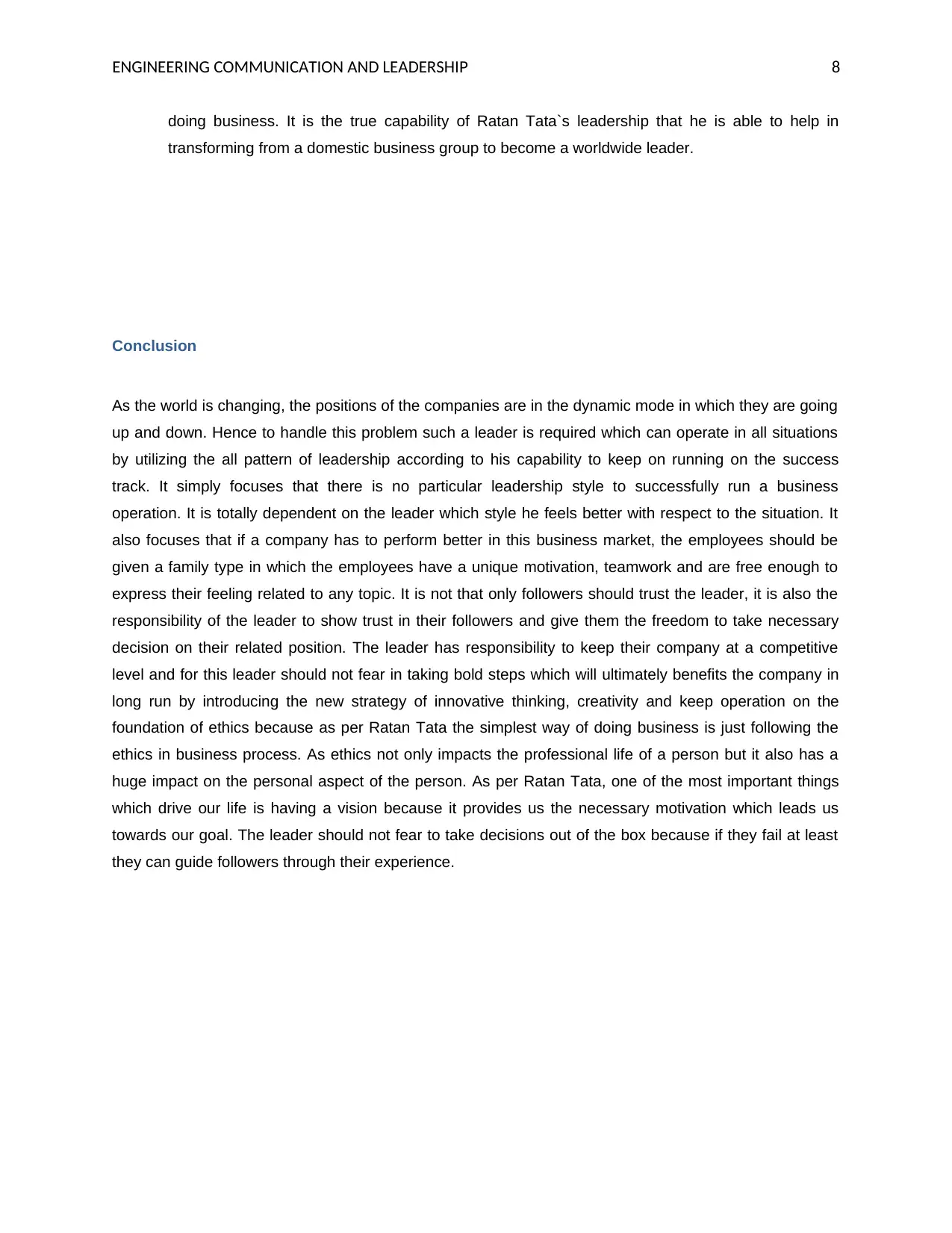
ENGINEERING COMMUNICATION AND LEADERSHIP 8
doing business. It is the true capability of Ratan Tata`s leadership that he is able to help in
transforming from a domestic business group to become a worldwide leader.
Conclusion
As the world is changing, the positions of the companies are in the dynamic mode in which they are going
up and down. Hence to handle this problem such a leader is required which can operate in all situations
by utilizing the all pattern of leadership according to his capability to keep on running on the success
track. It simply focuses that there is no particular leadership style to successfully run a business
operation. It is totally dependent on the leader which style he feels better with respect to the situation. It
also focuses that if a company has to perform better in this business market, the employees should be
given a family type in which the employees have a unique motivation, teamwork and are free enough to
express their feeling related to any topic. It is not that only followers should trust the leader, it is also the
responsibility of the leader to show trust in their followers and give them the freedom to take necessary
decision on their related position. The leader has responsibility to keep their company at a competitive
level and for this leader should not fear in taking bold steps which will ultimately benefits the company in
long run by introducing the new strategy of innovative thinking, creativity and keep operation on the
foundation of ethics because as per Ratan Tata the simplest way of doing business is just following the
ethics in business process. As ethics not only impacts the professional life of a person but it also has a
huge impact on the personal aspect of the person. As per Ratan Tata, one of the most important things
which drive our life is having a vision because it provides us the necessary motivation which leads us
towards our goal. The leader should not fear to take decisions out of the box because if they fail at least
they can guide followers through their experience.
doing business. It is the true capability of Ratan Tata`s leadership that he is able to help in
transforming from a domestic business group to become a worldwide leader.
Conclusion
As the world is changing, the positions of the companies are in the dynamic mode in which they are going
up and down. Hence to handle this problem such a leader is required which can operate in all situations
by utilizing the all pattern of leadership according to his capability to keep on running on the success
track. It simply focuses that there is no particular leadership style to successfully run a business
operation. It is totally dependent on the leader which style he feels better with respect to the situation. It
also focuses that if a company has to perform better in this business market, the employees should be
given a family type in which the employees have a unique motivation, teamwork and are free enough to
express their feeling related to any topic. It is not that only followers should trust the leader, it is also the
responsibility of the leader to show trust in their followers and give them the freedom to take necessary
decision on their related position. The leader has responsibility to keep their company at a competitive
level and for this leader should not fear in taking bold steps which will ultimately benefits the company in
long run by introducing the new strategy of innovative thinking, creativity and keep operation on the
foundation of ethics because as per Ratan Tata the simplest way of doing business is just following the
ethics in business process. As ethics not only impacts the professional life of a person but it also has a
huge impact on the personal aspect of the person. As per Ratan Tata, one of the most important things
which drive our life is having a vision because it provides us the necessary motivation which leads us
towards our goal. The leader should not fear to take decisions out of the box because if they fail at least
they can guide followers through their experience.
⊘ This is a preview!⊘
Do you want full access?
Subscribe today to unlock all pages.

Trusted by 1+ million students worldwide
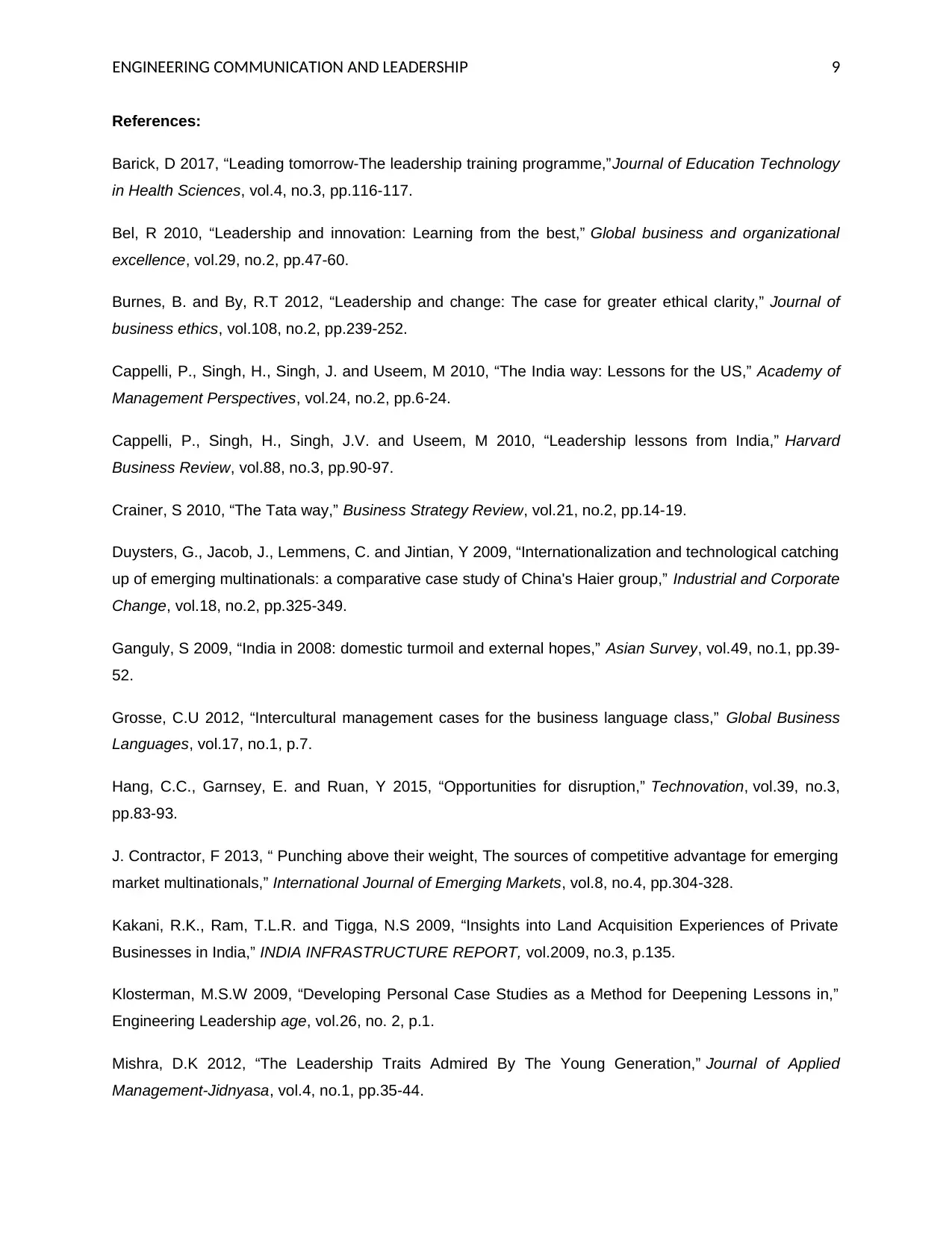
ENGINEERING COMMUNICATION AND LEADERSHIP 9
References:
Barick, D 2017, “Leading tomorrow-The leadership training programme,”Journal of Education Technology
in Health Sciences, vol.4, no.3, pp.116-117.
Bel, R 2010, “Leadership and innovation: Learning from the best,” Global business and organizational
excellence, vol.29, no.2, pp.47-60.
Burnes, B. and By, R.T 2012, “Leadership and change: The case for greater ethical clarity,” Journal of
business ethics, vol.108, no.2, pp.239-252.
Cappelli, P., Singh, H., Singh, J. and Useem, M 2010, “The India way: Lessons for the US,” Academy of
Management Perspectives, vol.24, no.2, pp.6-24.
Cappelli, P., Singh, H., Singh, J.V. and Useem, M 2010, “Leadership lessons from India,” Harvard
Business Review, vol.88, no.3, pp.90-97.
Crainer, S 2010, “The Tata way,” Business Strategy Review, vol.21, no.2, pp.14-19.
Duysters, G., Jacob, J., Lemmens, C. and Jintian, Y 2009, “Internationalization and technological catching
up of emerging multinationals: a comparative case study of China's Haier group,” Industrial and Corporate
Change, vol.18, no.2, pp.325-349.
Ganguly, S 2009, “India in 2008: domestic turmoil and external hopes,” Asian Survey, vol.49, no.1, pp.39-
52.
Grosse, C.U 2012, “Intercultural management cases for the business language class,” Global Business
Languages, vol.17, no.1, p.7.
Hang, C.C., Garnsey, E. and Ruan, Y 2015, “Opportunities for disruption,” Technovation, vol.39, no.3,
pp.83-93.
J. Contractor, F 2013, “ Punching above their weight, The sources of competitive advantage for emerging
market multinationals,” International Journal of Emerging Markets, vol.8, no.4, pp.304-328.
Kakani, R.K., Ram, T.L.R. and Tigga, N.S 2009, “Insights into Land Acquisition Experiences of Private
Businesses in India,” INDIA INFRASTRUCTURE REPORT, vol.2009, no.3, p.135.
Klosterman, M.S.W 2009, “Developing Personal Case Studies as a Method for Deepening Lessons in,”
Engineering Leadership age, vol.26, no. 2, p.1.
Mishra, D.K 2012, “The Leadership Traits Admired By The Young Generation,” Journal of Applied
Management-Jidnyasa, vol.4, no.1, pp.35-44.
References:
Barick, D 2017, “Leading tomorrow-The leadership training programme,”Journal of Education Technology
in Health Sciences, vol.4, no.3, pp.116-117.
Bel, R 2010, “Leadership and innovation: Learning from the best,” Global business and organizational
excellence, vol.29, no.2, pp.47-60.
Burnes, B. and By, R.T 2012, “Leadership and change: The case for greater ethical clarity,” Journal of
business ethics, vol.108, no.2, pp.239-252.
Cappelli, P., Singh, H., Singh, J. and Useem, M 2010, “The India way: Lessons for the US,” Academy of
Management Perspectives, vol.24, no.2, pp.6-24.
Cappelli, P., Singh, H., Singh, J.V. and Useem, M 2010, “Leadership lessons from India,” Harvard
Business Review, vol.88, no.3, pp.90-97.
Crainer, S 2010, “The Tata way,” Business Strategy Review, vol.21, no.2, pp.14-19.
Duysters, G., Jacob, J., Lemmens, C. and Jintian, Y 2009, “Internationalization and technological catching
up of emerging multinationals: a comparative case study of China's Haier group,” Industrial and Corporate
Change, vol.18, no.2, pp.325-349.
Ganguly, S 2009, “India in 2008: domestic turmoil and external hopes,” Asian Survey, vol.49, no.1, pp.39-
52.
Grosse, C.U 2012, “Intercultural management cases for the business language class,” Global Business
Languages, vol.17, no.1, p.7.
Hang, C.C., Garnsey, E. and Ruan, Y 2015, “Opportunities for disruption,” Technovation, vol.39, no.3,
pp.83-93.
J. Contractor, F 2013, “ Punching above their weight, The sources of competitive advantage for emerging
market multinationals,” International Journal of Emerging Markets, vol.8, no.4, pp.304-328.
Kakani, R.K., Ram, T.L.R. and Tigga, N.S 2009, “Insights into Land Acquisition Experiences of Private
Businesses in India,” INDIA INFRASTRUCTURE REPORT, vol.2009, no.3, p.135.
Klosterman, M.S.W 2009, “Developing Personal Case Studies as a Method for Deepening Lessons in,”
Engineering Leadership age, vol.26, no. 2, p.1.
Mishra, D.K 2012, “The Leadership Traits Admired By The Young Generation,” Journal of Applied
Management-Jidnyasa, vol.4, no.1, pp.35-44.
Paraphrase This Document
Need a fresh take? Get an instant paraphrase of this document with our AI Paraphraser
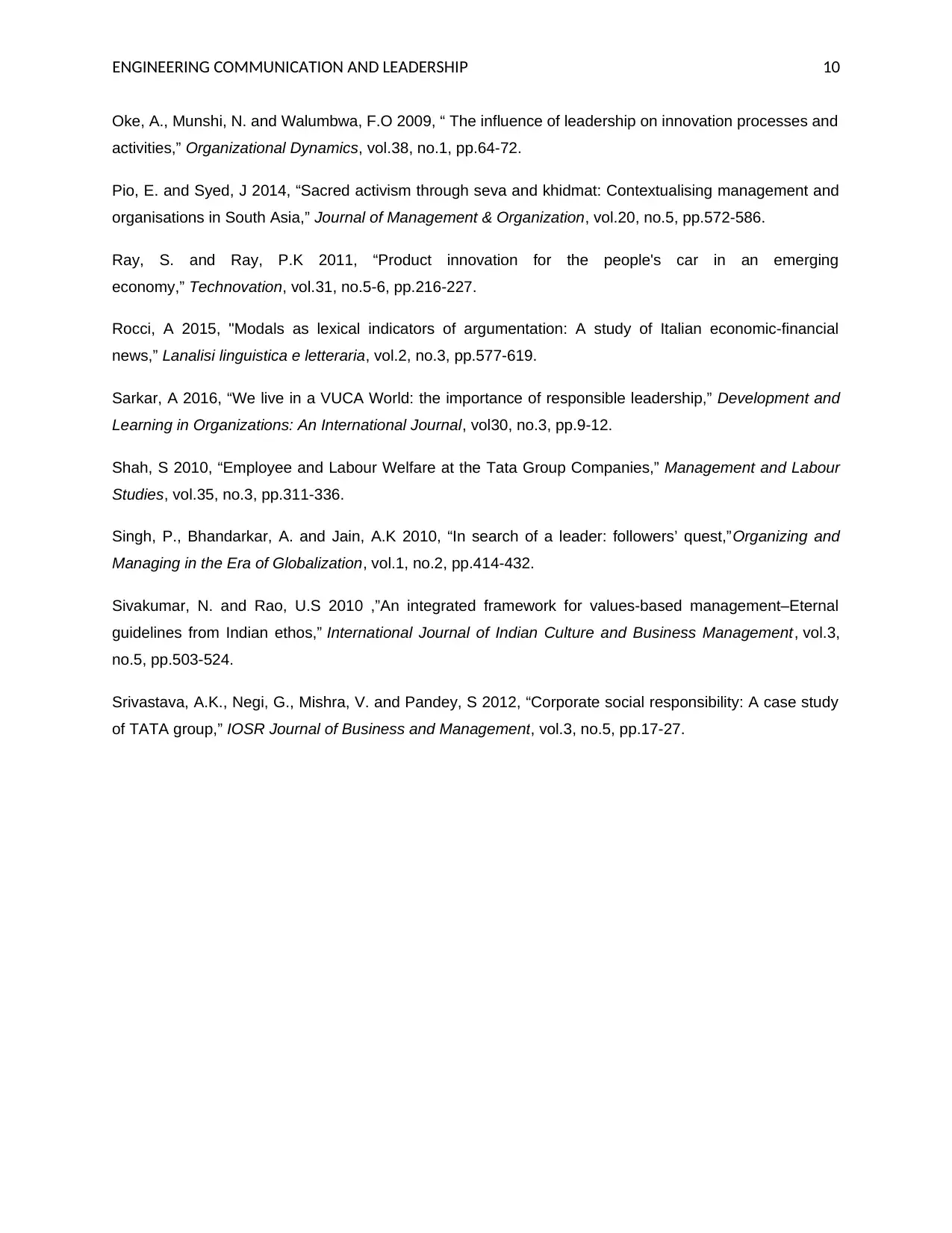
ENGINEERING COMMUNICATION AND LEADERSHIP 10
Oke, A., Munshi, N. and Walumbwa, F.O 2009, “ The influence of leadership on innovation processes and
activities,” Organizational Dynamics, vol.38, no.1, pp.64-72.
Pio, E. and Syed, J 2014, “Sacred activism through seva and khidmat: Contextualising management and
organisations in South Asia,” Journal of Management & Organization, vol.20, no.5, pp.572-586.
Ray, S. and Ray, P.K 2011, “Product innovation for the people's car in an emerging
economy,” Technovation, vol.31, no.5-6, pp.216-227.
Rocci, A 2015, "Modals as lexical indicators of argumentation: A study of Italian economic-financial
news,” Lanalisi linguistica e letteraria, vol.2, no.3, pp.577-619.
Sarkar, A 2016, “We live in a VUCA World: the importance of responsible leadership,” Development and
Learning in Organizations: An International Journal, vol30, no.3, pp.9-12.
Shah, S 2010, “Employee and Labour Welfare at the Tata Group Companies,” Management and Labour
Studies, vol.35, no.3, pp.311-336.
Singh, P., Bhandarkar, A. and Jain, A.K 2010, “In search of a leader: followers’ quest,”Organizing and
Managing in the Era of Globalization, vol.1, no.2, pp.414-432.
Sivakumar, N. and Rao, U.S 2010 ,”An integrated framework for values-based management–Eternal
guidelines from Indian ethos,” International Journal of Indian Culture and Business Management, vol.3,
no.5, pp.503-524.
Srivastava, A.K., Negi, G., Mishra, V. and Pandey, S 2012, “Corporate social responsibility: A case study
of TATA group,” IOSR Journal of Business and Management, vol.3, no.5, pp.17-27.
Oke, A., Munshi, N. and Walumbwa, F.O 2009, “ The influence of leadership on innovation processes and
activities,” Organizational Dynamics, vol.38, no.1, pp.64-72.
Pio, E. and Syed, J 2014, “Sacred activism through seva and khidmat: Contextualising management and
organisations in South Asia,” Journal of Management & Organization, vol.20, no.5, pp.572-586.
Ray, S. and Ray, P.K 2011, “Product innovation for the people's car in an emerging
economy,” Technovation, vol.31, no.5-6, pp.216-227.
Rocci, A 2015, "Modals as lexical indicators of argumentation: A study of Italian economic-financial
news,” Lanalisi linguistica e letteraria, vol.2, no.3, pp.577-619.
Sarkar, A 2016, “We live in a VUCA World: the importance of responsible leadership,” Development and
Learning in Organizations: An International Journal, vol30, no.3, pp.9-12.
Shah, S 2010, “Employee and Labour Welfare at the Tata Group Companies,” Management and Labour
Studies, vol.35, no.3, pp.311-336.
Singh, P., Bhandarkar, A. and Jain, A.K 2010, “In search of a leader: followers’ quest,”Organizing and
Managing in the Era of Globalization, vol.1, no.2, pp.414-432.
Sivakumar, N. and Rao, U.S 2010 ,”An integrated framework for values-based management–Eternal
guidelines from Indian ethos,” International Journal of Indian Culture and Business Management, vol.3,
no.5, pp.503-524.
Srivastava, A.K., Negi, G., Mishra, V. and Pandey, S 2012, “Corporate social responsibility: A case study
of TATA group,” IOSR Journal of Business and Management, vol.3, no.5, pp.17-27.
1 out of 11
Related Documents
Your All-in-One AI-Powered Toolkit for Academic Success.
+13062052269
info@desklib.com
Available 24*7 on WhatsApp / Email
![[object Object]](/_next/static/media/star-bottom.7253800d.svg)
Unlock your academic potential
Copyright © 2020–2025 A2Z Services. All Rights Reserved. Developed and managed by ZUCOL.





